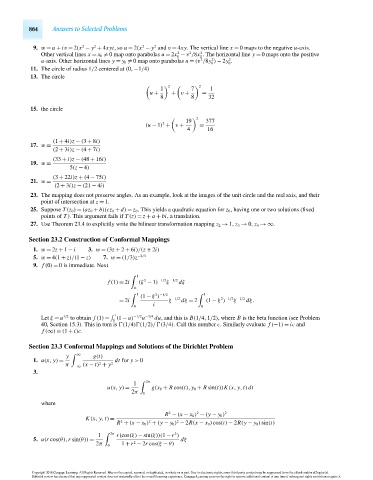Page 884 - Advanced_Engineering_Mathematics o'neil
P. 884
864 Answers to Selected Problems
2
2
2
2
9. w = u + iv = 2(x − y + 4xyi,so u = 2(x − y and v = 4xy. The vertical line x = 0 maps to the negative u-axis.
2
2
2
Other vertical lines x = x 0
= 0 map onto parabolas u = 2x − v /8x . The horizontal line y = 0 maps onto the positive
0 0
2
2
2
u-axis. Other horizontal lines y = y 0
= 0 map onto parabolas u = (v /8y ) − 2y .
0 0
11. The circle of radius 1/2 centered at (0,−1/4)
13. The circle
2 2
1 7 1
u + + v + =
8 8 32
15. the circle
2
19 377
2
(u − 1) + v + =
4 16
(1 + 4i)z − (3 + 8i)
17. w =
(2 + 3i)z − (4 + 7i)
(33 + i)z − (48 + 16i)
19. w =
5(z − 4)
(3 + 22i)z + (4 − 75i)
21. w =
(2 + 3i)z − (21 − 4i)
23. The mapping does not preserve angles. As an example, look at the images of the unit circle and the real axis, and their
point of intersection at z = 1.
25. Suppose T (z 0 ) = (az 0 + b)(cz 0 + d) = z 0 . This yields a quadratic equation for z 0 , having one or two solutions (fixed
points of T ). This argument fails if T (z) = z + a + bi, a translation.
27. Use Theorem 23.4 to explicitly write the bilinear transformation mapping z 2 → 1, z 3 → 0, z 4 →∞.
Section 23.2 Construction of Conformal Mappings
1. w = 2z + 1 − i 3. w = (3z + 2 + 6i)/(z + 2i)
5. w = 4(1 + z)/(1 − z) 7. w = (1/3)z −2/3
9. f (0) = 0 is immediate. Next
1
2
f (1) = 2i (ξ − 1) −1/2 −1/2 dξ
ξ
0
2 −1/2
1 (1 − ξ ) 1
2 −1/2 −1/2
= 2i ξ −1/2 dξ = 2 (1 − ξ ) ξ dξ.
0 i 0
Let ξ = u 1/2 to obtain f (1) = 0 1 (1 − u) −1/2 −3/4 du, and this is B(1/4,1/2),where B is the beta function (see Problem
u
40, Section 15.3). This in turn is (1/4) (1/2)/ (3/4). Call this number c. Similarly evaluate f (−1) = ic and
f (∞) = (1 + i)c.
Section 23.3 Conformal Mappings and Solutions of the Dirichlet Problem
y ∞ g(t)
1. u(x, y) = dt for y > 0
2
π −∞ (x − t) + y 2
3.
1 2π
u(x, y) = g(x 0 + R cos(t), y 0 + R sin(t))K(x, y,t)dt
2π 0
where
2
2
R − (x − x 0 ) − (y − y 0 ) 2
K(x, y,t) =
2
2
2
R + (x − x 0 ) + (y − y 0 ) − 2R(x − x 0 )cos(t) − 2R(y − y 0 )sin(t)
1 2π r(cos(ξ) − sin(ξ))(1 −r )
2
5. u(r cos(θ),r sin(θ)) = dξ
2
2π 0 1 +r − 2r cos(ξ − θ)
Copyright 2010 Cengage Learning. All Rights Reserved. May not be copied, scanned, or duplicated, in whole or in part. Due to electronic rights, some third party content may be suppressed from the eBook and/or eChapter(s).
Editorial review has deemed that any suppressed content does not materially affect the overall learning experience. Cengage Learning reserves the right to remove additional content at any time if subsequent rights restrictions require it.
October 14, 2010 17:50 THM/NEIL Page-864 27410_25_Ans_p801-866

